
<a href="http://www.shutterstock.com/cat.mhtml?lang=en&language=en&ref_site=photo&search_source=search_form&version=llv1&anyorall=all&safesearch=1&use_local_boost=1&autocomplete_id=&search_tracking_id=CQ_wUaS4IMFrrHJ8UKpl0A&searchterm=police%20officer%20death&show_color_wheel=1&orient=&commercial_ok=&media_type=images&search_cat=&searchtermx=&photographer_name=&people_gender=&people_age=&people_ethnicity=&people_number=&color=&page=1&inline=241549918">a katz</a>/Shutterstock
Police officers working in states with higher rates of private gun ownership are significantly more likely to be killed on the job than officers working in states with low levels of gun ownership, according to a new study on occupational homicides.
The study, published by the American Journal of Public Health on Thursday, analyzed FBI data focusing on the number of law enforcement officials that were killed between 1996 to 2010. During that period, 716 out of the total 782 police killings were found to be carried out by the use of firearms. Handguns were responsible for 515 of all the homicides.
“If we’re interested in protecting police officers, we need to look at what’s killing them, and what’s killing them is guns,” the study’s lead author David Swedler of the University of Illinois at Chicago School of Public Health noted in an academic news release.
A firearm present in a domestic violence situation also increases the likelihood of an officer being killed.
Researchers also discovered that the 23 states with the highest levels of gun ownership were three times as likely to have an officer killed by a gun than the eight states with the lowest rates of gun ownership. Interestingly, the study also found that
Alabama, Alaska, Arkansas, Mississippi, and Montana recorded both the highest levels of gun ownership and police killings. Connecticut, Massachusetts, New Jersey, New York, and Rhode Island had the lowest levels for both.
For more on where America’s guns are, check out Mother Jones‘ charts here.
















